Upcomming Events
-
21Paush
-
23PaushAraniko Smriti Day 2 days remaning
-
24PaushNepal Astrology Council Establishment Day 3 days remaning
-
27PaushPrithivi Jayanti/Rashtriya Ekata Diwas/Gorakhkali Puja 6 days remaning
-
29PaushNational Bhakka Day 8 days remaning
-
30PaushShattila Ekadashi 9 days remaning
-
1MaghMakar Sankranti/Ghiu chaku khane Din/Uttarayan Arambha 10 days remaning
-
2MaghNational Earthquake Safety Day/Pradosh Vrata 11 days remaning
-
5MaghSonam Lhochhar/Shree Ballav Jayanti 14 days remaning
-
8MaghTilkunda Chauthi 17 days remaning
-
9MaghBasanta Panchami vrata/Saraswati Pooja 18 days remaning
-
10MaghSkanda Sasti/Achala Saptami/International Day of Education 19 days remaning
-
11MaghGorakhkali Puja/World Leprosy Day 20 days remaning
-
12MaghInternational Custom Day 21 days remaning
-
13MaghDron Nawami 22 days remaning
-
15MaghBhima Ekadashi Vrata 24 days remaning
-
16MaghSahid Diwas/Pradosh Vrata 25 days remaning
-
18MaghShree Swasthani Brata Samapti/Poornima Wrata 27 days remaning
-
19MaghWorld Wetlands Day 28 days remaning
-
21MaghWorld Cancer Day 30 days remaning
-
25MaghRavisaptami Vrata 34 days remaning
-
26MaghGorakhkali Puja 35 days remaning
-
28MaghInternational Day of Women and Girls in Science/Safer Internet Day 37 days remaning
-
1FalgunKumbha Sankranti/Bijaya Ekadashi Vrata/World Radio Day 39 days remaning
-
2FalgunShani Pradosh Vrata/Valentine's Day 40 days remaning
-
3FalgunMaha-Shivaratri / Army Day/Silachahre Puja 41 days remaning
-
6FalgunGyalpo Lhosar 44 days remaning
-
7FalgunPrajatantra Diwas / Election Day 45 days remaning
-
8FalgunWorld Day of Social Justice 46 days remaning
-
9FalgunInternational Mother Language Day 47 days remaning
-
12FalgunBhaumashtami Wrata/Gorakhkali Puja 50 days remaning
-
15FalgunAmalaki Ekadashi Vrata/World NGO Day 53 days remaning
-
17FalgunPradosh Vrata/Zero Discrimination Day 55 days remaning
-
18FalgunFagu Poornima / Holi/Poornima Vrata 56 days remaning
-
19FalgunFagu Poornima (Terai)/Khandagras Chandra Grahan/World Wildlife Day 57 days remaning
-
20FalgunTel Lagaune Ra Aapko Mujura Khane Din 58 days remaning
-
24FalgunInternational Womens Day 62 days remaning
-
27FalgunGorakhkali Puja 65 days remaning
-
1ChaitraMeen Sankranti/Paapmochini Ekadashi Brata/World Consumer Rights Day 69 days remaning
-
2ChaitraSom Pradosh Vrata 70 days remaning
Jyotish
-
Jyotish Vaman Sapkotaशिक्षा - व्याकरणाचार्य, पौरोही...
-
Jyotish Damodar Poudelनेपाल संस्कृत विश्व बिद्यालय�...
-
Jyotish Pandit Mukunda Nepalज्योतिष पण्डित मुकुन्द नेपाल�...
-
Jyotish Mohan Ghimireसम्पुर्णानन्द संस्कृत विश्वव...
-
Jyotish Purushottam Ghimireनेपाल संस्कृत विश्वविद्यालय, �...
-
Jyotish Narayan Prasad Bhandariज्योतिषका उप-प्राध्यापक (lecturer of A...
-
 Jyotish Dharmendra Krishna Paudelशास्त्री धर्मेन्द्र कृष्ण पौ�...
Jyotish Dharmendra Krishna Paudelशास्त्री धर्मेन्द्र कृष्ण पौ�...
-
Jyotish Narayan Prasad Gautamगुरुकुल शिक्षा प्रणालीबाट ज्�...
-
Jyotish Amrit Paudelवाराणसीकै सम्पूर्णानन्द संस्...
-
Jyotish Khageshwor Subediगुरुकुल पद्दति बाट ज्योतिषीय �...
-
Jyotish Krishna Prasad Bhandariउपप्राध्यापक (Asst. professor of Sanskrit) नेपा�...
-
Jyotish Smarika Acharyaबाल्मीकि बिद्यापिठ बाट ज्योत�...
-
Jyotish Dipendra Khatiwadaसम्पुर्णानन्द संस्कृत बिश्वब...
-
 Jyotish Kuresh Pandey११ वर्षको अनुभवसहित विभिन्न ध�...
Jyotish Kuresh Pandey११ वर्षको अनुभवसहित विभिन्न ध�...
-
Jyotish Deepak Prasad Kafleसम्पूर्णानन्द संस्कृत विश्वव...
-
 Jyotish Mukunda Sharmaस्वाध्याय, सत्सङ्ग र सदाचारजस�...
Jyotish Mukunda Sharmaस्वाध्याय, सत्सङ्ग र सदाचारजस�...
-
Jyotish Damodar Kaushikज्योतिष र व्याकरण विषयमा आचार�...
-
Jyotish Hamro patroनेपाल संस्कृत विश्वविद्यालय �...
-
Jyotish Ghanashyam Pokharelनेपाल संस्कृत विश्वविद्यालयब...
Hororscope
कार्तिक शुक्ल प्रतिपदा
Gobardan Puja | Mha Puja | Gai Goru Puja | Haltihar | Nepal Sambat 1142
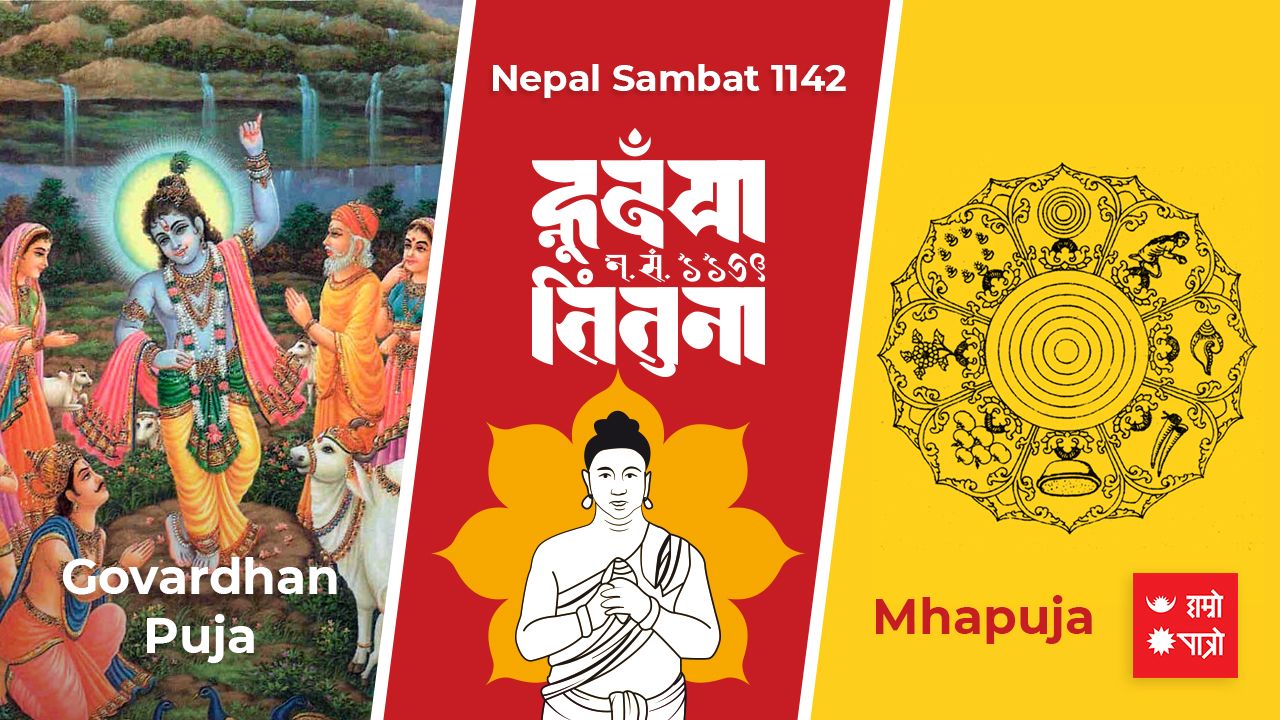
In the Newari community today, it is customary to celebrate Mha puja and value self-existence. In the Newari language, there is a predominance of small words like Mha, Mha means self,, and puja is worship, so today is respecting self and acknowledging the preciousness of life.
Sometimes, I feel that this is one of the most scientific and social cultures, as today Newa people take time to value self and re-realize the value of living.
May this day translate the message of hope to everyone in the globe, COVID-19 has several impacts and adversities but there is a silver lining, we just have to wait, live and smile.
Today is also the day to enlighten the self and give the impression of liveliness. If we examine the use and history of the word mhan in the Newari language, we find that its use is widely used in prefixes and suffixes in generic sentences.
Mha Fu la? How are you?
Mha means the word for body and consciousness, Mha is not used in unconscious and inanimate objects. Highlighting this consciousness and self-element, it is customary in the Newar community to celebrate Mhapuja today.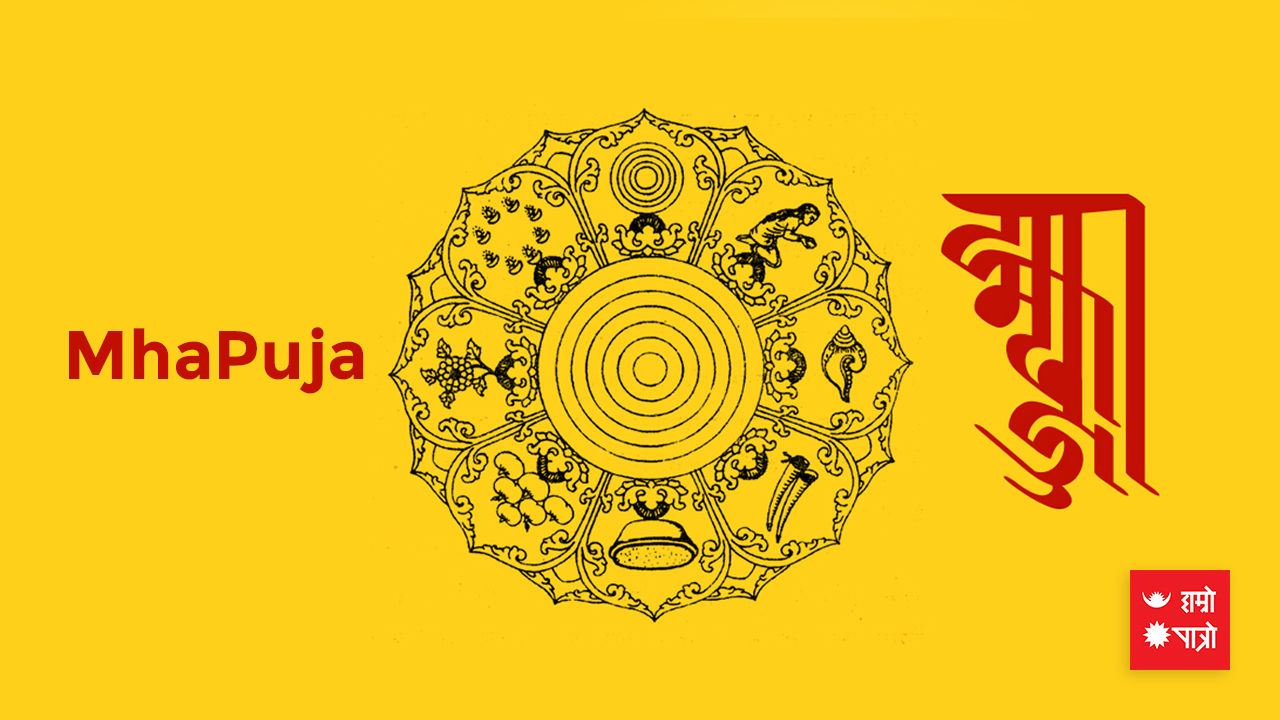
In the Newari community, worshiping and self-realizing self and the divine within one's own body is practiced onon this day. According to the belief that there can be no peace without peace in the body, today an attractive mandapa symbolizing Ashta Chiranjeevi and Ashta Aishwarya is worshiped and one feeds oneself by placing various food items on the mandapa.
Gai Goru Puja, Haltihar
Today cow, oxen, traditional wooden plow (Hali or halo), and other agricultural implements are worshipped. With the onset of winter in the agricultural doors of Nepal, it is customary to take out the tools such as plows, and spades that have been kept after the rainy season for worship. Hali means plow, so this Tihar is called Hali Tihar, we worship agricultural tools on this day.
Another big highlight of the day is Deusi. Yesterday's Bhaile's Vaka and today Deunse's Vaka. Of course, due to the Corona tragedy and the health crisis, these interesting things will not continue this year, but we will rejoice in the memories of the previous year and cultivate hope for forthcomings.
Deunse is a pre-historic storytelling and singing tradition, where a group of people visits a neighbor's doorstep, courtyard, and organize a musical and lyrical event for a short time. This is a traditional way of storytelling, those Deunse narrates several stories of ancient King Bali and other ancient pauranik characters. Later Deunse receives foods, grains, money, and thanks from the house owner, the ceremony ends with the flow of best wishes and blessings to the house owner, family, and society.
Utmost wishes for the coming years.
Gobardan Puja 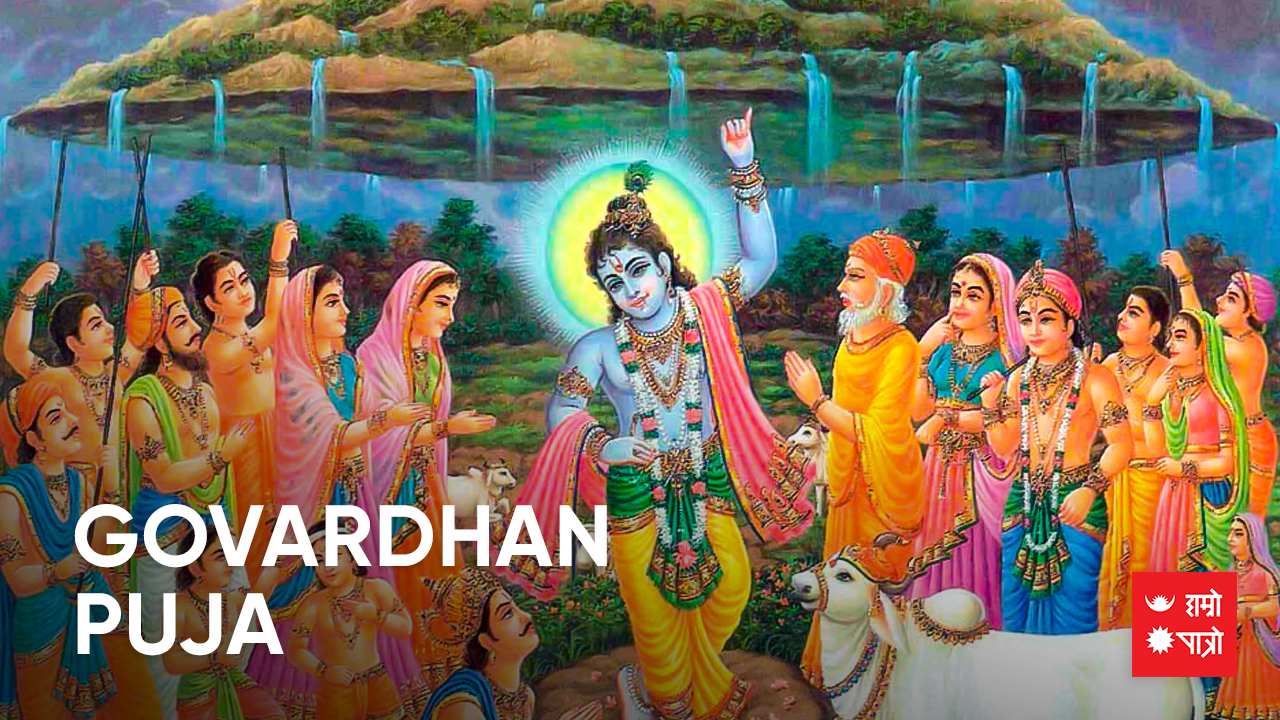
Today is Gobardhan Puja, Gobar means the holy cow dung so today Sanatan people acknowledge the importance of the mother cow. Crows, dogs, cows, and other animals involved in ancient agricultural work are hugely acknowledged in Yamapanchak days. Gobardhan Puja reminds us of the importance placed on our agricultural life by animals.
It is mentioned in the Bhagavad Gita that Lord Krishna lifted the Gobardhan mountain with his little finger to save the people of Dwarika from the catastrophe caused by the incessant rains that fell in Gokul due to the wrath of King Indra of heaven.
It is also mentioned that Indra today regretted his behavior and apologized to Lord Krishna. Today, the same Gobardhana mountain that Sri Krishna lifted with his finger is worshiped. Thus, while worshiping Gobardhan mountain, it has been customary to worship the Gobar as a symbol of Gobardhan mountain.
Not just cows but oxen are also worshipped today. If we remember the ancient Nepali society, carts pulled by animals including ox carts were the main means of transportation from one place to another and the main bases of agricultural work. For these cows and oxen, today they are given a mixture of flour, salt, bran, and water cooked like a pancake.
Another big highlight of the day is Deusi. Yesterday's Bhaile's Vaka and today Deunse's Vaka. Of course, due to the Corona tragedy and the health crisis, these interesting things will not continue this year, but we will rejoice in the memories of the previous year and cultivate hope for forthcomings.
Deunse is a pre-historic storytelling and singing tradition, where a group of people visits a neighbor's doorstep, courtyard, and organize a musical and lyrical event for a short time. This is a traditional way of storytelling, those Deunse narrates several stories of ancient King Bali and other ancient pauranik characters. Later Deunse receives foods, grains, money, and thanks from the house owner, the ceremony ends with the flow of best wishes and blessings to the house owner, family, and society.
Nepal Sambat 1142 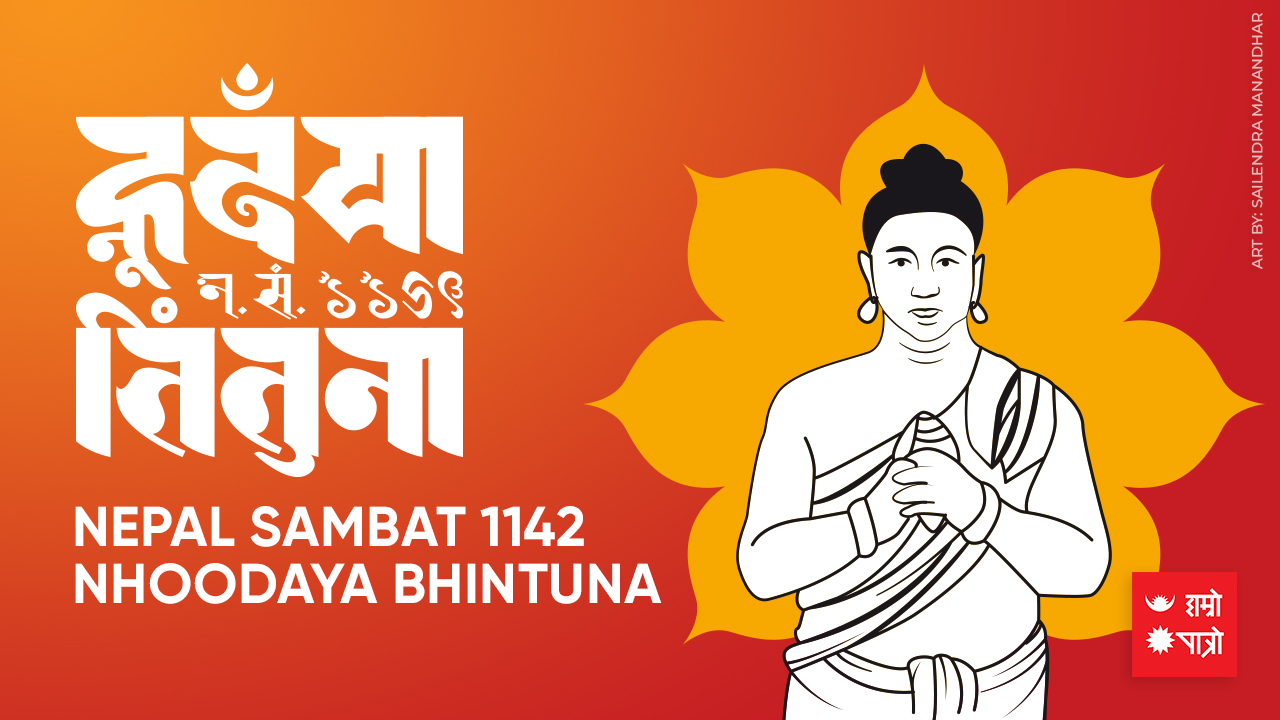
Today, the Newar community living in and out of the Kathmandu Valley celebrates the new year (Nepal Sambat) i.e. "Nhudanya Bhintuna" (exchange of New Year greetings) and develops ethnic unity and ancestral common culture. This Samvat, especially considered by the Newar community, is also a fundamental Samvat of Nepal.
Nepal Samvat is the epoch run by national luminary Shankhadhar Sakhwa by freeing the people across the country from debt. On this occasion, Bhintuna rallies are being held all over the country and abroad saying 'Nhudanya Bhintuna'.
Nepal Samvat is based on the lunar month. The first day of Nepal Samvat falls on the day of Kartik Shukla Paksha of Bikram Samvat.
There is a history of Nepal Samvat in government offices from the time of King Raghav Dev of Bhaktapur to the time of Chandra Shamsher. In this Samvat a month is measured between one no moon day (Aaunshi) to another Aaunshi and in this Samvat a year of 354 days falls.
According to the Nepal Samvat, the months are called Kachla, Thinla, Ponhela, Silla, Chilla, Chwala, Banchala, Tanthala, Della, Gunla, Nala, and Kaula respectively. The Government of Nepal has also given official recognition to this Samvat. In the Newari community, this samvat is widely used and measured.
Welcome to the month of Kachla of Nepal 1142.
Suyog Dhakal
Upcomming Events
-
21Paush
-
23PaushAraniko Smriti Day 2 days remaning
-
24PaushNepal Astrology Council Establishment Day 3 days remaning
-
27PaushPrithivi Jayanti/Rashtriya Ekata Diwas/Gorakhkali Puja 6 days remaning
-
29PaushNational Bhakka Day 8 days remaning
-
30PaushShattila Ekadashi 9 days remaning
-
1MaghMakar Sankranti/Ghiu chaku khane Din/Uttarayan Arambha 10 days remaning
-
2MaghNational Earthquake Safety Day/Pradosh Vrata 11 days remaning
-
5MaghSonam Lhochhar/Shree Ballav Jayanti 14 days remaning
-
8MaghTilkunda Chauthi 17 days remaning
-
9MaghBasanta Panchami vrata/Saraswati Pooja 18 days remaning
-
10MaghSkanda Sasti/Achala Saptami/International Day of Education 19 days remaning
-
11MaghGorakhkali Puja/World Leprosy Day 20 days remaning
-
12MaghInternational Custom Day 21 days remaning
-
13MaghDron Nawami 22 days remaning
-
15MaghBhima Ekadashi Vrata 24 days remaning
-
16MaghSahid Diwas/Pradosh Vrata 25 days remaning
-
18MaghShree Swasthani Brata Samapti/Poornima Wrata 27 days remaning
-
19MaghWorld Wetlands Day 28 days remaning
-
21MaghWorld Cancer Day 30 days remaning
-
25MaghRavisaptami Vrata 34 days remaning
-
26MaghGorakhkali Puja 35 days remaning
-
28MaghInternational Day of Women and Girls in Science/Safer Internet Day 37 days remaning
-
1FalgunKumbha Sankranti/Bijaya Ekadashi Vrata/World Radio Day 39 days remaning
-
2FalgunShani Pradosh Vrata/Valentine's Day 40 days remaning
-
3FalgunMaha-Shivaratri / Army Day/Silachahre Puja 41 days remaning
-
6FalgunGyalpo Lhosar 44 days remaning
-
7FalgunPrajatantra Diwas / Election Day 45 days remaning
-
8FalgunWorld Day of Social Justice 46 days remaning
-
9FalgunInternational Mother Language Day 47 days remaning
-
12FalgunBhaumashtami Wrata/Gorakhkali Puja 50 days remaning
-
15FalgunAmalaki Ekadashi Vrata/World NGO Day 53 days remaning
-
17FalgunPradosh Vrata/Zero Discrimination Day 55 days remaning
-
18FalgunFagu Poornima / Holi/Poornima Vrata 56 days remaning
-
19FalgunFagu Poornima (Terai)/Khandagras Chandra Grahan/World Wildlife Day 57 days remaning
-
20FalgunTel Lagaune Ra Aapko Mujura Khane Din 58 days remaning
-
24FalgunInternational Womens Day 62 days remaning
-
27FalgunGorakhkali Puja 65 days remaning
-
1ChaitraMeen Sankranti/Paapmochini Ekadashi Brata/World Consumer Rights Day 69 days remaning
-
2ChaitraSom Pradosh Vrata 70 days remaning
Jyotish
-
Jyotish Vaman Sapkotaशिक्षा - व्याकरणाचार्य, पौरोही...
-
Jyotish Damodar Poudelनेपाल संस्कृत विश्व बिद्यालय�...
-
Jyotish Pandit Mukunda Nepalज्योतिष पण्डित मुकुन्द नेपाल�...
-
Jyotish Mohan Ghimireसम्पुर्णानन्द संस्कृत विश्वव...
-
Jyotish Purushottam Ghimireनेपाल संस्कृत विश्वविद्यालय, �...
-
Jyotish Narayan Prasad Bhandariज्योतिषका उप-प्राध्यापक (lecturer of A...
-
 Jyotish Dharmendra Krishna Paudelशास्त्री धर्मेन्द्र कृष्ण पौ�...
Jyotish Dharmendra Krishna Paudelशास्त्री धर्मेन्द्र कृष्ण पौ�...
-
Jyotish Narayan Prasad Gautamगुरुकुल शिक्षा प्रणालीबाट ज्�...
-
Jyotish Amrit Paudelवाराणसीकै सम्पूर्णानन्द संस्...
-
Jyotish Khageshwor Subediगुरुकुल पद्दति बाट ज्योतिषीय �...
-
Jyotish Krishna Prasad Bhandariउपप्राध्यापक (Asst. professor of Sanskrit) नेपा�...
-
Jyotish Smarika Acharyaबाल्मीकि बिद्यापिठ बाट ज्योत�...
-
Jyotish Dipendra Khatiwadaसम्पुर्णानन्द संस्कृत बिश्वब...
-
 Jyotish Kuresh Pandey११ वर्षको अनुभवसहित विभिन्न ध�...
Jyotish Kuresh Pandey११ वर्षको अनुभवसहित विभिन्न ध�...
-
Jyotish Deepak Prasad Kafleसम्पूर्णानन्द संस्कृत विश्वव...
-
 Jyotish Mukunda Sharmaस्वाध्याय, सत्सङ्ग र सदाचारजस�...
Jyotish Mukunda Sharmaस्वाध्याय, सत्सङ्ग र सदाचारजस�...
-
Jyotish Damodar Kaushikज्योतिष र व्याकरण विषयमा आचार�...
-
Jyotish Hamro patroनेपाल संस्कृत विश्वविद्यालय �...
-
Jyotish Ghanashyam Pokharelनेपाल संस्कृत विश्वविद्यालयब...
Hororscope
Liked by:
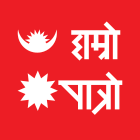

















 Mesh
Mesh Brish
Brish Mithun
Mithun Karkat
Karkat  Singha
Singha  Kanya
Kanya Tula
Tula Brischik
Brischik Dhanu
Dhanu  Makar
Makar  Kumbha
Kumbha Meen
Meen